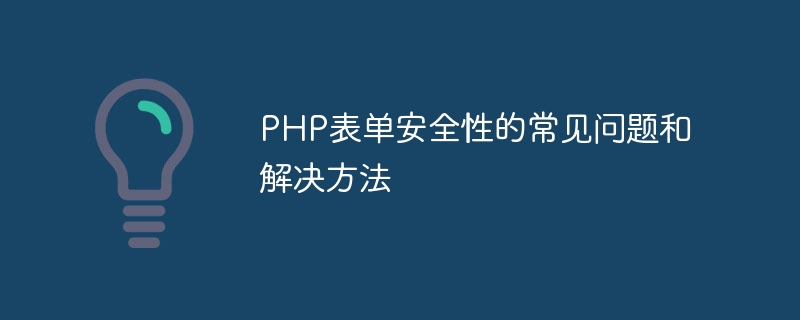Home >Backend Development >PHP Tutorial >Frequently Asked Questions and Solutions for PHP Forms Security
Frequently Asked Questions and Solutions for PHP Forms Security
- PHPzOriginal
- 2023-08-26 14:06:151397browse

Common problems and solutions to PHP form security
With the development of the Internet, more and more websites and applications use PHP to process user-submitted Form data. However, due to the lack of adequate security measures, PHP forms are often easy targets for malicious attacks. This article will introduce common problems with PHP form security and provide corresponding solutions.
1. Cross-site scripting attack (XSS)
Cross-site scripting attack is a common network security vulnerability. Attackers use website vulnerabilities to inject malicious scripts into users. These scripts will be executed in the user's browser to steal the user's sensitive information or perform other malicious behaviors.
Solution:
- Input filtering: For the form data submitted by the user, use PHP's built-in htmlspecialchars function for escaping processing to convert special characters into HTML entities to prevent malicious Script injection. The sample code is as follows:
$name = htmlspecialchars($_POST['name']);
- Output filtering: Before displaying the data submitted by the user on the web page, the data also needs to be filtered. Use the XSS filtering function strip_tags to remove HTML and PHP tags to prevent the execution of malicious scripts. The sample code is as follows:
echo strip_tags($name);
2. SQL injection attack
SQL injection attack means that the attacker injects SQL code into the input form to modify the database or obtain sensitive data. Purpose. This is a common attack method that poses a potential threat to the security of websites and user information.
Solution:
- Use parameterized queries or precompiled queries: For user-submitted data, use PDO or mysqli precompiled statements or parameter binding to build SQL query statements. This prevents malicious injection attacks. The sample code is as follows:
$stmt = $pdo->prepare('SELECT * FROM users WHERE username = :name');
$stmt->bindParam(':name', $name);
$stmt->execute();- Data input filtering: For user-entered data, use PHP's built-in filtering function to prevent it. For example, use the mysqli_real_escape_string function to escape special characters. The sample code is as follows:
$name = mysqli_real_escape_string($conn, $_POST['name']);
3. Form Forgery (CSRF)
The form forgery attack is an attack method that uses the user's identity to submit malicious requests without knowing it. Attackers forge requests and perform illegal actions by obtaining user login credentials.
Workaround:
- Use a CSRF token: Embed a randomly generated token in the form that is associated with the user's session. On form submission, verify the validity of the token. The sample code is as follows:
<form action="submit.php" method="post"> <input type="hidden" name="csrf_token" value="<?php echo $_SESSION['csrf_token']; ?>"> <!-- 其他表单元素 --> <input type="submit" value="提交"> </form>
session_start();
if ($_SERVER['REQUEST_METHOD'] === 'POST') {
if ($_POST['csrf_token'] === $_SESSION['csrf_token']) {
// 验证通过
} else {
// 验证失败,可能是CSRF攻击
}
}- Set Referer verification: Verify whether the source of the request is legitimate by checking the Referer field of the HTTP request header. Only allow specific sources to access the form submission page to prevent cross-site request forgery attacks. The sample code is as follows:
if (isset($_SERVER['HTTP_REFERER']) && parse_url($_SERVER['HTTP_REFERER'], PHP_URL_HOST) === 'example.com') {
// 合法的来源,允许提交表单
} else {
// 非法的来源,可能是CSRF攻击
}In summary, PHP form security issues mainly include cross-site scripting attacks, SQL injection attacks and form forgery issues. Through methods such as input and output filtering, parameterized query pre-compilation, and the use of CSRF tokens, these common attack methods can be effectively prevented and the security of users and websites protected. When developing PHP applications, it is crucial to keep security in mind.
The above is the detailed content of Frequently Asked Questions and Solutions for PHP Forms Security. For more information, please follow other related articles on the PHP Chinese website!

